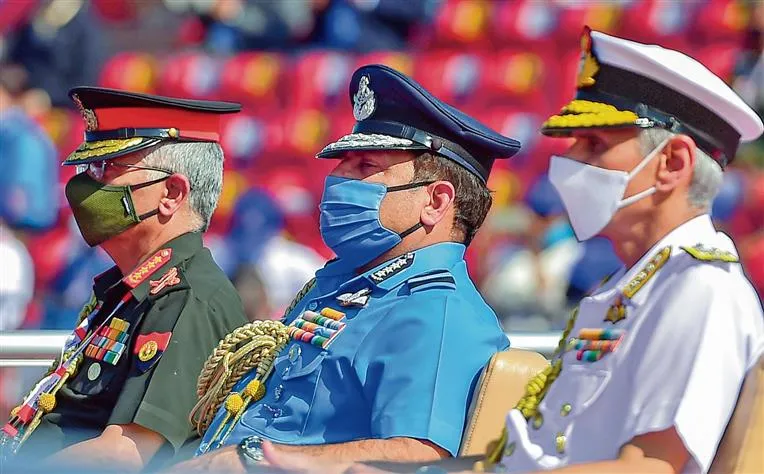-
CENTRES
Progammes & Centres
Location
Four years after creating the Chief of Defence Staff (CDS) post, the landmark plan of integrated theatre commands still needs to be implemented

Nearly four years after the Chief of Defence Staff post in the rank of a 4-star General was created to galvanise reforms, the wheels on integrated theatre commands are incrementally turning. Recent reports have suggested that after much contemplation, disagreement, and debate, the Army, Navy, and Air Force may have an agreement on the ideational framework that will arguably guide the biggest overhaul of India's military. Essentially, theatre commands bring the separate arms of the military under a single-unified command structure. Theatre commands operate under a single commander for a specific geographical region. These enable the military to combine resources and optimally use them for offensive and defensive operations.
For India, given the precarious situations on both its northern and western borders, theatre commands are essential for a unified approach to any future conflict. Estimates suggest India may need to utilise more than five of its military commands in any future conflict with China. As a report from the RAND Corporation explains, future conflicts will involve all elements of warfare, including cyber, thus, a theatre command structure becomes even more essential.
The pivot to a theatre system will provide India with an integrated warfighting capacity that can deter threats, while also reducing operational costs.
The pivot to a theatre system will provide India with an integrated warfighting capacity that can deter threats, while also reducing operational costs. Theatre commands also synergise the combat capabilities of the three services to deal with conflicts.
Significantly, theatre commands are contrary to the current practice of the Indian military. Specifically, out of the 19 existing commands, 17 are single-service oriented—seven Army, seven Air Force, and three Navy. Only the Andaman and Nicobar Command and the Strategic Forces Command, in charge of the country's nuclear stockpile, function as tri-services commands.
Though late CDS General Bipin Rawat had planned for the theatre commands to be operational by early 2023, a combination of reasons has delayed their implementation. These include differences among the three forces on scope, structure, and control of the commands.
Further, contention has also been on the kind of war-fighting equipment that will be deployed under a single command. At the same time, ambiguity surrounding the transfer of weapons, platforms, and resources from one theatre command to another has also added to the delay.
Beyond India, major military powers, including the United States (US), the United Kingdom (UK), Russia, and France, all operate under theatre commands. In 2016, China pivoted towards theatre commands, including the Western Theatre Command, which amongst other regions, focuses on the Line of Actual Control (LAC) with India.
Though the exact contours of India's theatre commands are not finalised, enough material in public has highlighted the different shapes it has taken over the last three years.
Early reports in 2021 suggested that the military aimed to bring together and reorganise India's 17 single commands into 4 or 5 theatre commands.
These commands were believed to include the Northern Land Theatre, which would look after Jammu and Kashmir, Ladakh and the Central sector, the Western Land Theatre, which would focus on Pakistan, the Eastern Land Theatre, the Maritime Theatre Command and the Air Defence Command. Further, these commands were also supposed to be supplemented with logistics and training commands. However, in 2023, with the guidance of CDS Anil Chauhan, the plan seems to have been reworked with a proposal for three integrated theatre commands instead.
These commands, reports suggest, will be under senior 3-star officers of either Lt General, Air Marshal, or Vice Admiral rank. This plan is deemed to have almost gained consensus within the military.
The three proposed theatre commands are supposed to look after the northern front with China, the western borders with Pakistan, and also include a maritime command towards Southern India. Significantly, the idea of the Air Defence Command (ADC) from the earlier iteration has been dropped. From the onset, the Air Force resisted the idea of an ADC. The Air Force's asset shortages— in terms of both personnel and limited squadron strength would have pushed the decision-makers to abandon the idea. While India has an authorised strength of 42 fighter squadrons, only 31 are currently operational. Further, the Air Force was also wary of splitting its limited air assets amongst the commands. The division of leadership of commands was also a source of quandary for them.
In essence, the shift towards three theatre commands reflects a more pragmatic restructuring whereby the existing commands are incorporated into three bigger units, instead of creating multiple larger commands which could create initial administrative problems. As theatre commands will involve officers working across domains of the three services, a reworking of human resource policies in the military is also underway. The military has recently cross-posted 102 officers from one service to another to ensure they understand the workings of other services.
These transfers are an important step in ensuring integration, and a clear indication of the needle moving towards integrated theatre commands.
Central to the upside of theatre commands is the integrated warfighting capacity and jointness it will provide India's military. The forces will be able to pool their resources efficiently, resulting in the optimum utilisation of platforms, weapon systems, and assets.
Theatre commands, in the long run, could also improve logistics management in the forces. A framework to collectively cater to the requirements of the three services could prove more beneficial than individual plans. This will also prevent resources from being allocated for duplicate purchases for the three services.
Currently, India's multiple military commands are all located in different geographical areas. This, at times, causes communication hindrances during joint operations and exercises. As multiple levels of clearances across hierarchies and geographies are needed to corroborate plans and strategies. With a unified command structure, these communication processes could be simpler and more efficient.
Further, in the realm of policy, having a unified command structure with representatives from all three services will also lead to more efficient planning for both peacetime and wartime strategies.
While the theorised benefits of theatre commands are worth pondering, there are still a few miles to go before India implements them. Institutional inertia and parochial interests that value the status quo will have to be overcome as a precursor to implementing the transition.
While the theorised benefits of theatre commands are worth pondering, there are still a few miles to go before India implements them.
Further, in terms of preparing the educational bedrock for military personnel to serve in theatre commands, the country seems to be behind the curve. The curriculum at staff colleges and war colleges can be reworked to provide officers with the knowledge and transferable skills to serve at the headquarters of corresponding services. This, in the long run, could prepare them to hold positions of responsibility in theatre commands.
Further, many retired military professionals have criticised implementing theatre commands without having a coherent National Security Strategy (NSS). Essentially arguing that the theatre commands will not have a clear blueprint and policy objective to work towards without an NSS.
In essence, as India moves towards implementing its biggest military overhaul, which could undoubtedly be a force multiplier, a few institutional and ideational changes will have to be incorporated to find the correct balance in such a transformation.
Suchet Vir Singh is an Associate Fellow with the Strategic Studies Programme at the Observer Research Foundation.
The views expressed above belong to the author(s). ORF research and analyses now available on Telegram! Click here to access our curated content — blogs, longforms and interviews.

Suchet Vir Singh is a defence analyst. Until recently, he was an Associate Fellow at the Observer Research Foundation. His research interests include India’s defence services, ...
Read More +